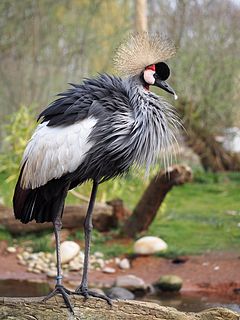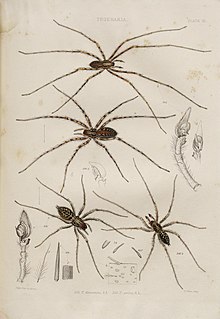
The black crowned crane is a part of the family Gruidae, along with its sister, the Grey crowned crane. It is topped with its characteristic bristle-feathered golden crown. It is usually found in the shallow wetlands of sub-Saharan Africa during the wet season, which act as its principal breeding, feeding and roosting sites although it can also be found foraging in grasslands and near croplands of dry savanna.

The hobo spider is a member of the genus of spiders known colloquially as funnel web spiders, but not to be confused with the Australian funnel-web spider. Individuals construct a funnel-shaped structure of silk sheeting and lie in wait at the small end of the funnel for prey insects to blunder onto their webs. Hobo spiders sometimes build their webs in or around human habitations. The hobo spider lays its eggs in September and they hatch during late spring. After the male hobo spider mates it dies.

The bird genus Balearica contains two extant species in the crane family Gruidae: the black crowned crane and the grey crowned crane.

The coat of arms of Uganda was adopted three weeks before the proclamation of independence by the Uganda Legislative Council. On 1 October 1962 the arms were approved by Governor of Uganda Walter Coutts, and formally established by law on 9 October.

The spider species Tegenaria domestica, commonly known as the barn funnel weaver in North America and the domestic house spider in Europe, is a member of the funnel-web family Agelenidae and a close relative of the hobo spider.

The giant house spider has been treated as either one species, under the name Eratigena atrica, or as three species, E. atrica, E. duellica and E. saeva. As of April 2020, the three species view was accepted by the World Spider Catalog. They are among the largest spiders of Central and Northern Europe. They were previously placed in the genus Tegenaria. In 2013, they were moved to the new genus Eratigena as the single species Eratigena atrica. In 2018, the three separate species were restored. The bite of these species does not pose a threat to humans or pets, and they are generally reluctant to bite, preferring instead to hide or escape.
The name house spider is a generic term for different spiders commonly found around human dwellings, and may refer to:

Hispania Balearica was a Roman province encompassing the Balearic Islands off the east coast of modern Spain. Formerly a part of Hispania Tarraconensis, Balearica gained its autonomy due to its geographic separation and economic independence from the mainland. The province included three major islands: Balearis Major (Majorca), Balearis Minor (Minorca), and Ebusus (Ibiza), and the small island of Colubraria or Ophiusa (Formentera). The islands were grouped as the Gymnesiae—Majorca and Minorca, and the Pityusae—Ibiza and Formentara.

Tegenaria parietina is a rather rare spider in Europe, with a distribution also including Northern Africa to Central Asia and Sri Lanka, and from the West Indies to Uruguay and Argentina, where it may be introduced. In the UK it is sometimes known as the cardinal spider because of the legend that Cardinal Wolsey was terrified by this species at Hampton Court, or, conversely, because he regarded them as lucky and forbade anyone to harm them. In 2013, Tegenaria taprobanica was included in this species.
A crowned crane is a bird of the genus Balearica:
Pseudomonas balearica is a Gram-negative, rod-shaped, nonfluorescent, motile, and denitrifying bacterium. It is an environmental bacterium that has been mostly isolated from polluted environments all over the world. Many of the isolates have demonstrated capabilities to degrade several compounds. Some of the strains are naphthalene degraders and one strain isolated in New Zealand has demonstrated the potential to oxidize inorganic sulfur compounds to tetrathionate. Based on 16S rRNA analysis, P. balearica has been placed in the P. stutzeri group.
A hobo is a migratory worker or homeless vagabond, often penniless.
Naufraga balearica is an extremely species of flowering plant in the family Apiaceae, and the only species in the monotypic genus Naufraga. It is endemic to the Spanish island of Majorca, where it is found only at the base of cliffs at the north of the island near Pollença. A population was discovered on Corsica in 1981, but it had died out by 1983, and it is not clear whether it arrived naturally. Its natural habitats are Mediterranean-type shrubby vegetation and rocky shores.

Eratigena is a genus of spider in the family Agelenidae. Most of its species were moved from the genus Tegenaria in 2013. Two species that frequently build webs in and around human dwellings are now placed in this genus. Eratigena agrestis is the hobo spider, native to Europe and Central Asia, introduced to North America. Eratigena atrica is the giant house spider, native to Europe and also introduced into North America.
Aterigena is a genus of funnel weavers first described by A. Bolzern, A. Hänggi & D. Burckhardt in 2010. The name is an anagram of Tegenaria. It was created in 2010 for a group of Tegenaria and Malthonica species that formed a clade in a phylogenetic analysis. The genus was later found to be monophyletic, further separating Eratigena from Tegenaria and Malthonica.
Chatzakia is a genus of spiders in the family Gnaphosidae. It was first described in 2016 by Lissner & Bosmans. As of 2017, it contains only one species, Chatzakia balearica, found on the Balearic Islands.
Eratigena arganoi is a species of spider in the genus Eratigena found in Italy.

Eratigena duellica, the giant house spider, is a species of funnel weaver in the spider family Agelenidae. It is found in Canada, the United States, and Europe. The related species Eratigena atrica is also called the Giant house spider.








